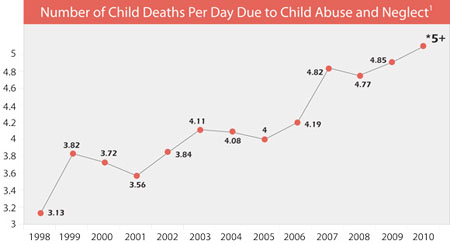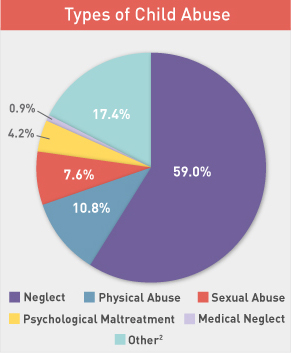Indications of Child Abuse & Family Violence
What is Maltreatment
What should you do first! Call your local police or Child Protective Services.
Need help by phone now: Call the Childhelp USA® National Child Abuse Hotline at 1-800-4-A-CHILD® (1-800-422-4453).
When you have concerns for a child's well-being, the indicators listed below
may help guide you in your thought process. Many of these "symptoms" or
"signs" could be caused by things other than abuse or neglect. Generally,
these indicators do indicate that a child's safety may be at risk and, at
the very least, the situation should be assessed by a professional able to
determine the causes of these symptoms and offer the help and assistance
necessary to reduce the risk to a child.
Signs of Physical Abuse- child and adult
Child Abuse Physical Indicators
- Unexplained bruises and welts on the face, throat, upper arms, buttocks, thighs or lower back
in unusual patterns or shapes which suggests the use of an instrument
(belt buckle, electric cord) on an infant
in various stages of healing
regularly appear after absence, weekend, or vacation
- Unexplained burns cigarette burns, especially found on palms, soles of feet, abdomen,
buttocks immersion burns producing "stocking" or "Glove" demarcations on hands and
feet; "doughnut shaped" on buttocks or genital area
- rope burns
- infected burns indicating delay in treatment
burns in the shape of common household utensils or appliances
Behavioral Indicators
- behavioral extremes (withdrawal, aggression, regression, depression)
- inappropriate or excessive fear of parent or caretaker
- antisocial behavior such as substance abuse, truancy, running away
fear of going home
- unbelievable or inconsistent explanation for injuries
- lies unusually still while surveying surroundings (for infants)
- unusual shyness, wariness of physical contact
Signs of Sexual Abuse
Physical Indicators
- torn, stained or bloody underclothes
- frequent, unexplained sore throats, yeast or urinary infections
- somatic complaints, including pain and irritation of the genitals
- sexually transmitted diseases
- bruises or bleeding from external genitalia, vagina or anal region
- pregnancy
Behavioral Indicators
- the victim's disclosure of sexual abuse
- regressive behaviors (thumb-sucking, bedwetting, fear of the dark)
- promiscuity or seductive behaviors
- disturbed sleep patterns (recurrent nightmares)
- unusual and age-inappropriate interest in sexual matters
- avoidance of undressing or wearing extra layers of clothes
- sudden decline in school performance, truancy
- difficulty in walking or sitting
Signs of Emotional Abuse
Physical Indicators
- eating disorders, including obesity or anorexia
- speech disorders (stuttering, stammering)
- developmental delays in the acquisition of speech or motor skills
- weight or height level substantially below norm
- flat or bald spots on head (infants)
- nervous disorders (rashes, hives, facial tics, stomach aches)
Behavioral Indicators
- habit disorders (biting, rocking, head-banging)
- cruel behavior, seeming to get pleasure from hurting children, adults or
animals; seeming to get pleasure from being mistreated
- age-inappropriate behaviors (bedwetting, wetting, soiling)
- behavioral extremes; overly compliant-demanding; withdrawn-aggressive;
listless-excitable
Signs of Neglect
Physical Indicators
- poor hygiene, including lice, scabies, severe or untreated diaper rash,
bedsores, body odor
- squinting
- unsuitable clothing; missing key articles of clothing (underwear, socks
shoes); overdressed or underdressed for climate conditions
- untreated injury or illness
- lack of immunizations
- indicators or prolonged exposure to elements (excessive sunburn, insect
bites, colds)
- height and weight significantly below age level
Behavioral Indicators
- unusual school attendance
- chronic absenteeism
- chronic hunger, tiredness, or lethargy
- begging or collecting leftovers
- assuming adult responsibilities
- reporting no caretaker at home
excerpt from: ChildHelp at http://www.childhelp.org/pages/statistics/
How Can I Tell If A Child May Be Abused or Neglected?
It is not necessary that you decide if a child is abused or
neglected. Child abuse and neglect are not always easy to identify.
For example, bruises may or may not have been caused by abuse.
A child coming to school with head lice or dirty clothes may
or may not be due to neglect.
Yet, hundreds of people across the country are charged with
the duty to be aware of the children they see and work with daily,
and to report suspicions of child abuse, neglect, or dependency.
Your interaction with so many children, your professional
training regarding child development, and your innate sense of
a child's well-being, gives you the ability and responsibility
to protect children from abuse and neglect.
Recognizing a child in need of protection goes beyond the
legal definitions of abuse, neglect and dependency.
It is an accumulation of everything you know and sense about
a child or a situation. Recognition does not always come about
in a concrete way. It can be an inner voice that tells you that
something is just not right. That's when you should call Children's Services.
What Are the Legal Definitions of Child Abuse and
Neglect?
The full legal definitions of abuse, neglect and dependency
are rather lengthy. You can look up the entire text in the Ohio
Revised Code sections referenced below. However, they can be
summarized as follows:
Abused child
(taken from O.R.C. 2151.031): Any child who is the victim
of sexual activity, is endangered, or exhibits evidence of any
injury or death inflicted other than by accidental means, or
at variance with the history given of it, or because of acts
or omissions of his parents, guardians, or custodian, suffers
physical or mental injury that harms or threatens a child's health
of welfare.
Neglected child (taken from O.R.C. 2151.03): Any child
who is abandoned by his parents, guardian or custodian, lacks
adequate parental care because of the faults of the parents,
or whose parents neglect or refuse to provide him with proper
or necessary sustenance, education, medical or surgical care,
or any other care made necessary by his mental condition.
Dependent child (taken from O.R.C. 2151.04): Any child
who is homeless, destitute or without adequate parental care
through no fault of his parents, guardian or custodian; who lacks
proper care or support by reason of the mental or physical condition
of his environment, in such as to warrant the State, in the interest
of the child, to assume his guardianship; or any child who is
residing in a household in which a parent, guardian or custodian
or other member of the household has committed an act that was
the basis for an accusation that a sibling of the child, or another
child who resides in the household is an abused, neglected or
dependent child and, because of circumstances surrounding the
abuse or neglect of the sibling and other conditions of the household,
the child is in danger of being abused or neglected by that parent,
guardian, custodian or other member of that household.
It is important that you understand the intention of the laws
by defining child protection. The actions taken by County
Children Services after your referral is received are based on
what the law allows us to help the child and the family correct
its problem.
So, Do I Need To Investigate A Suspected Case Before
I Report It, To Make Sure It Meets The Legal Definitions?
You do not have to investigate to make sure your referral
is valid, or that it complies with legal definitions. When you
suspect a child's welfare is jeopardized, and make a referral
to Children Services, you help us identify the
potential need for our services.
Your feeling that something just isn't right with a child
is sufficient to warrant your call to Child Protective Services. The agency, then,
uses the investigative and legal process to manage your referral
and possibly open a case.
Four Main Divisions of Child Abuse
excerpt from: ChildHelp at http://www.childhelp.org/pages/statistics/
Neglect Physical Abuse
Sexual Abuse Emotional Abuse
NEGLECT
Neglect is when a parent/caregiver does not provide for the basic
emotional and physical needs of the child on an ongoing basis. Examples of neglect include
not providing the proper:
- food
- clothing
- housing
- supervision
- safe surroundings
- personal health care
- medical and emotional care
- education
Children who are neglected physically and emotionally may not develop
normally. Some children may suffer permanent damage.
PHYSICAL ABUSE
Physical abuse includes anything a parent/caregiver does that results
in physical harm to a child. Physical abuse may happen if a child is punished harshly,
even though the parent/caregiver may not have meant to hurt the child.
Examples of physical abuse include:
- bruises
- marks in the shape of objects or
handprints
- shaking
- burns
- human bite marks
- fractures of the skull, arms, legs and
ribs
- female genital mutilation
Physical abuse may result in a minor injury (such as a bruise) to a
more serious injury which could cause lasting damage or death (for example from shaking a
child).
SEXUAL ABUSE
Sexual abuse occurs when a person uses power over a child, and involves
the child in any sexual act. This abuser is more powerful because of age, intelligence,
physical strength, control over the child, and the child’s need to be taken care of
by others. The offender gets the child to participate by using threats, bribes, lying and
taking advantage of the child’s trust.
Sexual abuse includes involving the child in acts such as:
fondling (touching the child in a sexual
way)
getting the child to touch the adult
inappropriately
oral sex
inserting fingers, penis, or objects in
the vagina or anus
exposing oneself
allowing a child to watch pornography
involving a child in pornography or
prostitution.
Most sexual offenders are people the children know.
EMOTIONAL ABUSE
A parent/caregiver who continually uses any of the following when
interacting or disciplining a child is emotionally abusing the child.
rejecting (e.g., saying "I wish you were
never born")
criticizing (e.g., saying "Why can’t you
do anything right?")
insulting (e.g., saying "I can’t believe
you would be so stupid")
humiliating (e.g., embarrassing a child
in front of other people)
isolating (e.g., not allowing a child to
play with friends)
terrorizing (e.g., scaring a child by
saying "The police will come and take
you away")
corrupting (e.g., always swearing in
front of the child, or getting the child to
participate in things against the law)
not responding emotionally
punishing a child for exploring the
environment
Children who witness violence in their home may suffer emotional damage
watching a loved one being physically or verbally attacked.
Family Violence- men, women & children
Family Violence against men, women, and children are the future of our community. Here at preventfamilyviolence.com, we believe in the value of children. They have a right to a safe environment in which to grow and flourish.
Men, women, and children must be protected; and yet, sometimes they cannot protect themselves. Protecting each of us from abuse involves everyone. Helping abused and neglected men, women, and children is a duty we all share.
Information is a key component in family violence and child abuse prevention, here at www.preventfamilyviolence.com we offer current articles and reports on child abuse trends and what you can do to help combat abuse. Learning and understanding are also key components in fight against child abuse, here we offer a wide variety of articles, newsletters and learning material. Read, learn, and join in the fight against child abuse.
Facts about Family Violence
Acts of violence occur every 18 seconds in this country. A woman is abused every 9 seconds.
- 26% of murdered women are killed by their husbands or boyfriends
- 30% of women in emergency rooms are there because of injuries caused by abuse
- 25% of men will use violence against a partner at sometime during the relationship every 5 years.
- 30% of all murders in this country are committed within the family and 13% are committed by spouses.
- Children are present during 80% of the assaults against their mothers and 3 million children witness domestic violence each year.
- Many cases of domestic violence are not reported because of feelings of helplessness, fear and shame.
- Domestic Violence transcends racial, age and socioeconomic boundaries. Its victims are educated, uneducated, poor, middle class, and wealthy.
- Victims are every walk of life, every sociioeconomic status. They are Caucasian, Hispanic, African-American and are of every ethnic origin.
- Children who witness violence in the home learn that violence is the answer and these children are 1000 times more likely to abuse as adults.
- The death toll of persons killed by relatives and acquaintances equals that of the entire Vietnam War
Resources
Child abuse & Neglect US Dept of Health & Human Services
ChildHelp at http://www.childhelp.org/pages/statistics/
Related articles




 Find us on Facebook
Find us on Facebook Follow us on Twitter
Follow us on Twitter
 all rights reserved.
all rights reserved.